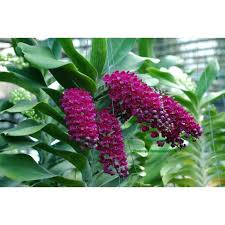# The Role of Da Châu Orchids in the Natural Ecosystem

Da Châu orchids (*Rhynchostylis gigantea*) are a remarkable species of orchids native to Southeast Asia, particularly thriving in countries like Vietnam, Thailand, and Myanmar. Renowned for their stunning beauty and distinctive fragrance, these orchids are not only cherished by horticulturists and plant enthusiasts but also play a significant role in their natural ecosystems. This article explores the multifaceted role of Da Châu orchids within their ecosystems, including their interactions with other species, their contribution to biodiversity, and their environmental significance.
## 1. Overview of Da Châu Orchids
Before delving into their ecological role, it is essential to understand the basic characteristics and requirements of Da Châu orchids. These epiphytic orchids typically grow on trees, utilizing them for support while deriving moisture and nutrients from the air and surrounding environment. Their vibrant flowers, which can range from white to various shades of purple and pink, attract various pollinators, contributing to their reproduction and the surrounding ecosystem’s health.
### 1.1 Botanical Characteristics
– **Family**: Orchidaceae
– **Genus**: Rhynchostylis
– **Species**: Rhynchostylis gigantea
– **Habitat**: Primarily found in tropical forests, on tree trunks, and in other high-humidity environments.
Da Châu orchids exhibit unique adaptations that allow them to thrive in their natural habitat. They possess thick roots that can absorb moisture from the air and have leaves that can withstand high humidity and fluctuating light levels.
## 2. Role in Biodiversity
Biodiversity refers to the variety of life forms in a particular ecosystem, including the diversity of species, genetics, and ecosystems. Da Châu orchids contribute significantly to the biodiversity of their native habitats.
### 2.1 Habitat for Various Species
Da Châu orchids serve as essential habitats for numerous organisms, including insects, birds, and other plants. The complex structures of these orchids create microhabitats that provide shelter and food for various species. For example, the dense foliage can offer protection for insects, while the flowers attract pollinators such as bees, butterflies, and hummingbirds.
### 2.2 Pollinator Relationships
The flowers of Da Châu orchids are highly specialized to attract specific pollinators, creating mutualistic relationships. When pollinators visit the orchids to collect nectar, they inadvertently transfer pollen from one flower to another, facilitating cross-pollination. This process not only aids in the reproduction of Da Châu orchids but also contributes to the overall genetic diversity of the species.
Pollinators are critical for the survival of many plant species, including Da Châu orchids, as they ensure successful fertilization and seed production. The decline of pollinator populations due to habitat loss and environmental changes poses a threat to these orchids and other flowering plants, highlighting the interconnectedness of ecosystems.
### 2.3 Seed Dispersal
Once Da Châu orchids produce seeds, they rely on various agents for dispersal, including wind and animals. The lightweight seeds can be carried by the wind over considerable distances, allowing them to colonize new areas. Additionally, birds and other animals that feed on the seeds can inadvertently assist in their dispersal through their droppings, promoting the growth of new orchid populations.
## 3. Contribution to the Food Web
Da Châu orchids are an integral part of the food web within their ecosystems. They provide nourishment for various species, from insects to larger animals.
### 3.1 Food Source for Insects
The nectar produced by Da Châu orchids serves as a food source for many insects, including bees, butterflies, and moths. These insects play crucial roles in pollination and contribute to the overall health of the ecosystem. Additionally, the presence of these insects attracts higher trophic levels, such as birds and small mammals that prey on them.
### 3.2 Interaction with Other Plant Species
Da Châu orchids often coexist with other plant species in their natural habitats. By forming symbiotic relationships with specific fungi (mycorrhizae), they enhance nutrient absorption from the soil. These fungi assist in breaking down organic matter, providing essential nutrients to the orchids while benefiting the surrounding flora.
Moreover, the presence of Da Châu orchids can influence the growth and distribution of nearby plant species. As they flourish, they create shade and alter microclimatic conditions, which can impact the growth patterns of other plants in the vicinity.
## 4. Environmental Significance
The ecological significance of Da Châu orchids extends beyond their immediate interactions with other organisms. They play vital roles in maintaining environmental balance and supporting ecosystem health.
### 4.1 Soil Stabilization
The roots of Da Châu orchids contribute to soil stabilization, particularly in their native forest habitats. As they anchor themselves to trees, their root systems help prevent soil erosion by stabilizing the substrate. This process is crucial in maintaining the integrity of forest ecosystems and preventing sediment runoff into waterways.
### 4.2 Indicator Species
Orchids, including Da Châu orchids, are often considered indicator species due to their sensitivity to environmental changes. Their presence and health can provide valuable insights into the overall condition of the ecosystem. A decline in orchid populations can signal deteriorating environmental conditions, such as habitat loss, pollution, or climate change.
### 4.3 Contribution to Carbon Sequestration
Plants, including orchids, play a critical role in carbon sequestration, a process that helps mitigate climate change. By absorbing carbon dioxide during photosynthesis, Da Châu orchids contribute to the overall reduction of greenhouse gases in the atmosphere. Their presence in tropical forests aids in maintaining carbon balance and promoting a healthier environment.
## 5. Conservation Concerns
Despite their ecological importance, Da Châu orchids face various threats that jeopardize their populations and, consequently, their roles in ecosystems.
### 5.1 Habitat Loss
One of the most significant threats to Da Châu orchids is habitat loss due to deforestation, urbanization, and agricultural expansion. As their natural habitats are destroyed, these orchids struggle to survive, leading to declines in their populations and disrupting the ecological balance.
### 5.2 Climate Change
Climate change poses a significant threat to Da Châu orchids and their ecosystems. Altered temperature and precipitation patterns can affect the delicate balance of their habitats, impacting their growth, reproduction, and overall survival.
### 5.3 Over-collection
The popularity of Da Châu orchids in horticulture has led to over-collection in the wild. Unsustainable harvesting practices can deplete natural populations, reducing genetic diversity and threatening the species’ survival.
## 6. Conservation Efforts
Recognizing the ecological significance of Da Châu orchids, various conservation efforts are underway to protect and preserve this remarkable species and its habitat.
### 6.1 Habitat Restoration
Efforts to restore degraded habitats can help provide suitable environments for Da Châu orchids to thrive. This may involve reforestation initiatives, invasive species management, and creating protected areas.
### 6.2 Sustainable Cultivation
Promoting sustainable cultivation practices for Da Châu orchids can reduce pressure on wild populations. Educating growers and enthusiasts about responsible harvesting techniques and the importance of preserving natural habitats is crucial.
### 6.3 Research and Monitoring
Ongoing research and monitoring of Da Châu orchid populations can provide valuable data on their status and the effectiveness of conservation efforts. Understanding their ecology, reproductive biology, and response to environmental changes is essential for developing effective conservation strategies.
### 6.4 Community Engagement
Engaging local communities in conservation efforts can foster a sense of stewardship and responsibility toward their natural resources. Involving local populations in habitat restoration projects and sustainable orchid cultivation can contribute to the long-term survival of Da Châu orchids.
## 7. Conclusion
Da Châu orchids play a vital role in their natural ecosystems, contributing to biodiversity, supporting the food web, and maintaining environmental balance. Their interactions with pollinators, other plant species, and their habitats underscore the intricate relationships that exist within ecosystems. However, the threats they face, including habitat loss and climate change, necessitate concerted conservation efforts to protect and preserve these remarkable orchids and their ecosystems.
Through habitat restoration, sustainable cultivation practices, research, and community engagement, we can ensure that Da Châu orchids continue to thrive, benefiting both the environment and the people who cherish their beauty. Understanding and appreciating the role of Da Châu orchids in the natural ecosystem is essential for fostering a sustainable relationship between humans and the environment, promoting a future where these stunning orchids can flourish in harmony with nature.

